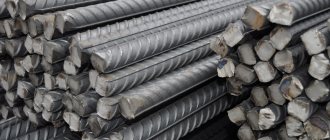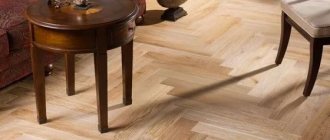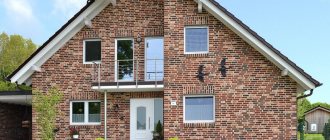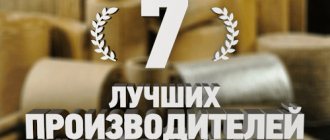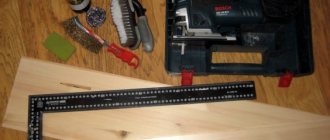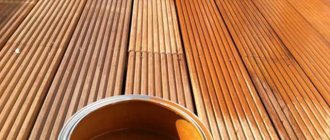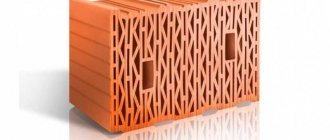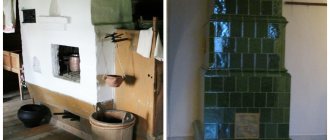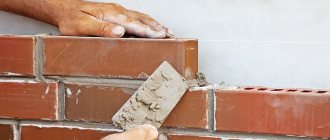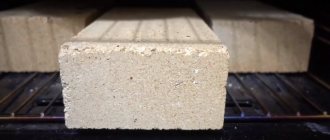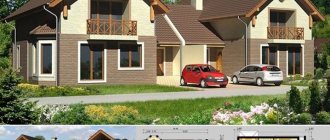Composition of hyperpressed bricks and production technology
The mixture for the production of hyperpressed bricks includes 8-15% high-grade cement, 2-7% iron oxide pigments for coloring and 85-92% of one of the main raw materials:
- Limestone-shell rock;
- Tyrsa, dolomite, marble, marl;
- Elimination from crushed stone production;
- Fight from the production of ceramic bricks;
- Various wastes: from mining and cutting facing stones, from the enrichment of coal, copper and iron ores;
- Blast furnace slag and many other materials.
Hyperpressing is a method of molding a product from a moistened mixture of mineral bulk materials at ultra-high pressure. The pressing effect leads to such strong mutual friction of particles that not just adhesion occurs between them, but adhesion at the molecular level, i.e. cohesion is an attraction that under normal conditions exists between molecules within a substance, but not between molecules of different substances.
The particles are essentially welded together, and this happens without the use of high temperatures, such as when firing clay bricks or welding metals. Therefore, semi-dry hyperpressing is also called cold welding. The result is an artificial material that is as close as possible in texture, strength, frost and moisture resistance to natural stone.
The molded products are dried in a steaming chamber (8–10 hours at 40–70 ºС) or in a warehouse, where the brick matures for 3–5 days. This allows you to gain 50-70% of brand strength, after which the bricks, if necessary, are rusticated (imitating decorative chips) and sent to the construction site. The hyperpressed brick gains its final strength already in the masonry within 30 days, provided the temperature is above zero.
The uniqueness of the technology lies in obtaining high-precision compliance of the finished product with the design dimensions. The deviation can be no more than 0.5 mm (usually in the range of 0.2-0.5), which impressively exceeds the performance of the most “accurate” sand-lime brick among wall elements with its ±2 mm.
There is no state standard developed specifically for hyper-pressed bricks, so manufacturers are guided by the technical specifications for products obtained by hyper-pressing, as well as standards (regarding size and purpose) for clay bricks:
- TU 5741-021-00284753-99 “Hyperpressed construction materials”
- GOST 530-2007 “Ceramic brick and stone. General technical conditions"
Stages of business organization, brief profitability analysis
Since we have decided to talk about profitability, it is worth briefly considering the main stages of creating a business that precede the launch of production.
Opening an organization, organizing production
Let's use the table. Table 1. Business plan for the production of hyperpressed bricks: stages of implementing a business idea.
On a note! It is recommended to first carefully study the price category of the commercial real estate market, since the cost per square meter can vary greatly.
Note! Certification of manufactured products is mandatory, which takes a lot of time. The duration of some tests reaches 120 days. So be prepared for this.
Technical and economic component
The profitability of production is influenced by many factors, which include:
- Region and its climatic conditions. That is, a climate suitable for using the material.
- Purchasing power of the region.
- Organizational expenses associated with conducting business activities, strict adherence to the business development plan.
- The cost of raw materials and equipment and, as a consequence, the cost of products.
- Advertising.
- The quality of the original products and much more.
It is not possible to make an accurate calculation of economic profitability, since everything is individual for each development path. We can only guess.
- Let's imagine that the cost of 1 unit of brick with texture is 18 rubles. Its market value is 22 rubles.
- The cost will include all expenses, including the tax base, deductions, employee salaries, rent, utility bills, and so on. In general, everything except the cost of the equipment.
- The daily output volume is, suppose, 4000 bricks. If we manage to sell all the products, then the income will be: 4000 * 4 = 16,000 rubles. As a rule, factory production runs uninterruptedly and seven days a week.
- Monthly income, in this case, will be 480,000 rubles.
- The cost of a budget conveyor line is about 5,000,000. This means that production will pay off in about 10 months.
Classification
Hyper-pressed brick has classification characteristics similar to two other types of bricks - ceramic and silicate:
- by purpose - ordinary and facial (smooth or embossed with a poke and/or spoon);
- by design - solid and hollow (perforated and slotted);
- in shape - in the form of a regular parallelepiped (with sharp or rounded corners) and figured.
Reference. Each pair of identical faces of a brick has its own name: bed - the largest (working) planes; spoons - medium-sized edges (it is they that remain visible in the finished masonry from the inside and outside); poke - the end faces of a brick.
Figured, or shaped, bricks can also be divided according to purpose: some perform a purely decorative function, others combine it with a practical one - cornice, corner, etc. The relief of facing bricks, also called chipping or “wild stone”, is created only on one or two edges.
Due to the fairly high cost, the use of building (ordinary) bricks is justified in the construction of earthquake-resistant buildings. Basically, products obtained by the method of double-sided hyperpressing serve as an excellent facing material, which, in addition to the decorative effect, strengthens the structure and protects from high humidity and other adverse influences.
Brick dimensions L×W×T, mm:
- Single (1NF) 250×120×65
- Narrow (0.6NF) 250×60×65
No less common are combinations of length and thickness of 230 and 65 mm with a width of 107, 100, 56 or 50 mm.
Main types of brick fences
There are two main types of brick fences - solid and combined. The significant weight of artificial stone forces property owners to consider the option of combined fencing. This design involves brick pillars for the fence and filling with lighter materials: corrugated sheets, wooden or metal picket fences. The fence looks solid, elegant, and the design features allow the cost of the fence to vary over a wide range.
Combined brick and picket fence Source techss.ru
A solid brick fence is heavy and requires a solid foundation. This can be a monolithic strip foundation or concrete blocks buried in the ground. The advantage of the design is high strength, reliability, durability. The service life of the fence exceeds 100 years; the fence does not require scheduled maintenance to maintain its appearance.
Solid fences demonstrate the high social status of the property owner and the presence of a sense of taste. The high cost of the structure, consisting of the cost of the foundation, delivery of materials, the price of work and bricks, limits the use of this type of fencing. The traditional solution is to design the front part of the site, which faces the street. Lighter structures are installed along the rest of the perimeter, allowing you to save not only money, but also useful space.
This is how a solid fence is made from hyper-pressed brick Source techss.ru
Solid fences can be laid in half a brick, in a brick or in one and a half bricks. The choice of design will have an impact on strength. A half-brick fence can easily withstand the impact of a motorcycle or car. The one-and-a-half-brick design can withstand a collision with a truck. Masonry can be done by any means. Stone of different shades and textures can be used. This affects the decorative characteristics of the enclosing structure.
Classic chain binding looks impressive with torn stone. English or Flemish masonry will give the fence an additional visual effect.
Characteristics
- Strength from 100 to 300-400 kg/cm²
- Double-sided hyperpressing ensures uniform strength of grades in terms of strength not lower than M100, and with the use of M500 cement - within M250-M300.
- Volumetric weight 1900-2200 kg/m³
- Thermal conductivity 0.43-1.09 W/(m °C)
- Frost resistance up to 300 cycles
- Brands from F30 to F300.
- Water absorption 3-7%
- Fire resistance group NG (non-flammable)
- The cost of solid and hollow, respectively, rub./piece: Basic costs approximately 30-32 and 21-26
- Narrow - 12-17 and 14.8-16.5
- Curly 32-44
What kind of material is this?
Hyperpressed brick is a high-strength building material, which is mainly used for cladding and construction of external structures: arches, gates, fences. This means that its front surfaces (poke and spoon) must be of ideal quality. Such masonry does not require further processing in the form of plastering walls or cladding, which significantly saves money and construction time. Hyper-pressed limestone brick can be machined; it is easily cut with a grinder with a low percentage of waste and scrap.
Advantages of hyperpressed bricks
- Resistant to aggressive environments and climatic influences;
- Surpasses most ceramic and any silicate products in strength;
- Ideally smooth surfaces ensure quick laying, saving masonry mortar and labor costs;
- It has no cracks or breaks, is durable in terms of service life (up to 200 years) and maintains aesthetics;
- Amenable to any mechanical processing directly on the construction site;
- The bonding strength with cement mortar is 75-100% higher than with ceramic mortar;
- The strength of masonry with cement mortar exceeds ceramic masonry bonded with the same mortar by 50-70%;
- Possibility of carrying out masonry work at any time of the year;
- Availability and environmental friendliness of the raw materials used.
Construction technology
Working with bricks when building a fence requires a highly qualified mason. The complexity of the masonry is comparable to the cladding of the facade of a house. It is necessary to involve experienced specialists in the work.
The construction of the fence is carried out in the following order:
- preparing a trench for a strip foundation;
- install formwork
- install pipes that play a reinforcing role during the construction of pillars;
- concrete is poured;
- lay waterproofing between the foundation and the enclosing structure;
- install poles;
- they are laying the fence.
It is recommended to install a brick fence cap and foundation drainage. These elements protect structural elements from rain streams during a rainstorm.
Work on the construction of the fence will begin only after the foundation has gained the necessary strength. The formwork can be removed after 7 days - during this time the concrete hardens. Strength is gained within 24 days. This time can be reduced by using special additives in concrete.
Brick made using hyperpressing technology has an ideal geometry. This makes it easier to work with the material, but the low water absorption coefficient makes it demanding on the masonry mortar used. A thicker solution of sand and cement or special masonry mixtures are used. This will not change the price for a brick fence, since the proportion between the binder, filler and water changes slightly.
It is possible to assemble brick spans without pillars Source techss.ru
Revenue and profitability
The average wholesale price for one-and-a-half solid bricks measuring 88x120x250 is 8 rubles. Subject to the use of the above equipment, the monthly sales revenue will be 1,300 thousand rubles, the net profitability of production is about 25%, Thus, the investments made in mini-brick production will pay off in about 8 months (subject to 100% load equipment) or 16 months when the production line is loaded at half capacity.
vote
Article Rating
Flaws
The most important disadvantage is the price, which limits the scope of application of this material mainly to finishing. In addition, as is the case with any finishing type of brick, there is a large load on the foundation structure, which forces you to spend more effort and money on preparing a strong and massive foundation for the structure.
Important! Another disadvantage can be considered that hyperpressed brick needs to be dried before work. And sometimes this process can take a long time.
Varieties
According to their design, hyperpressed bricks are divided into three groups:
- Full-bodied.
- Hollow. Up to 40% technical holes and cracks.
- Lego. This is a subspecies of hollow, which has two protrusions-spikes on the upper edges and two grooves on the lower ones. This lock provides better adhesion of the masonry.
According to its purpose, hyperpress bricks can be ordinary or construction, as well as facing. The latter type has many textures, shapes and colors:
- Yellow smooth "Lithos". With and without beveled corners.
- "Rock". Rough and softer texture.
- Cornice. With smooth curved curves.
- Angular. It has an L-shape for perfect finishing of corners.
- Snickers. A narrow brick with a chipped surface.
- Torn stone.
Brick produced using hyperpressing technology
The compressive and bending strength of bricks and the compressive strength of stones without deducting the void area must be no less than the values indicated in the table. Brick and stones must be frost-resistant and, when saturated with water, must withstand delamination, peeling, cracking, and spalling without any signs of visible damage: In certain southern climatic regions, with the permission of the State Construction Committee of the Union Republic, it is allowed to produce bricks and stones with frost resistance of at least 15 cycles of alternating freezing and thawing, if, based on the experience of past construction in these areas, these products ensure the durability of the external enclosing structures of buildings.
Bricks and stones of the highest quality category must meet the following requirements:. Glazed surfaces of bricks and stones of the highest quality category must additionally meet the following requirements:
Cons and weaknesses
The disadvantage of hyper-pressed brick is the cost, especially when it is used as an ordinary brick. It also has an increased thermal conductivity, which negatively affects the feasibility of use for main masonry. Heat from a house made with such bricks will leave faster. Minuses:
- Heavy weight. Even for slotted specimens it is 4.2 kg.
- Burnout. But there is no serious loss in color.
- The adhesion of the solution in the solid version is slightly worse than in the slotted version.
- Possible appearance of expulsions in the clutch.
Scope of application
Hyperpressed brick is sometimes used when laying foundations and plinths, but mainly it is an exterior and interior facing material. Arches and fences, columns and decorative elements of window and door openings are erected from its figured elements, fireplaces are lined and walls are decorated. This building material is very popular in landscape design. Thanks to the strong masonry, a house made of such bricks can be built in an area of seismic instability, possible landslides and other natural and man-made disasters.
Production
Many people are interested in the peculiarities of the production of such material.
Hyperpressed bricks are produced using a non-firing method. The manufacturer mixes cement and high-quality limestone, dilutes it with water, adds dyes and mixes the mixture thoroughly.
Semi-dry pressing uses a small amount of water. Its share in the material does not exceed 10% of the total mass.
From the resulting mass it forms the appropriate types of bricks. That is, full-bodied or hollow. Then the products are put under a hyperpress, which weighs 300 tons. The pressure reaches 25 MPa.
At the next stage, the workpieces end up in the steaming chamber. Here the brick is exposed to a temperature of 70 degrees Celsius for about 10 hours. Steaming allows the cement to gain the necessary moisture. As a result, the product gains almost 70% of its strength at this stage.
Another 30% is received within the next month after production is completed. Only after 1 month the brick is ready for use.
The absence of a cement film improves the adhesion of products compared to concrete. Plus, it provides self-ventilation and allows the walls to literally breathe. Also, we do not receive chipped and heterogeneous bricks, but products of the same and regular shape. This makes working with it much easier.
